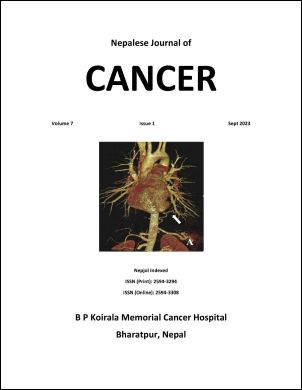Clinicopathological profile of Papillary thyroid carcinoma in a tertiary cancer hospital in Nepal
DOI:
https://doi.org/10.3126/njc.v7i1.60034Keywords:
papillary thyroid carcinoma, demographic profile, treatment modalities, clinicopathological characteristicsAbstract
Background: Differentiated thyroid cancers (DTC), including papillary thyroid carcinoma (PTC), are on the rise. This study provides a detailed examination of PTC cases in a tertiary care cancer hospital in Nepal, aiming to understand its clinical characteristics and treatment patterns. We conducted a retrospective analysis of PTC, including demographics, features of tumor, and treatment modalities.
Methods: A retrospective cross-sectional study assessed cases of PTC from January 2022 to December 2022. Patient data were collected and analyzed, focusing on demographics, tumor attributes, and treatment approaches.
Results: Among 105 patients, females were predominant (female-to-male ratio 5.2:1), and ethnic diversity was observed. Most patients were from Lumbini Pradesh. The mean age was 40.78 years. Fine-needle aspiration cytology (FNAC) showed Bethesda VI as the most common classification. Primary treatment involved total thyroidectomy (76.25%). Classical PTC was the major histopathological variant (78.1%). Tumors were frequently located in the right lobe (55.25%). Unifocal tumors were prevalent (74.28%), with an average size of 2.74 cm. Lymph node metastasis occurred in 49.5% of patients. Intermediate-risk patients constituted the majority (53.5%).
Conclusion: This study offers crucial insights into PTC's clinical spectrum in Nepal, aiding in tailored patient care strategies. The findings contribute to informed decision-making for enhanced treatment outcomes.
Downloads
Downloads
Published
How to Cite
Issue
Section
License
Copyright (c) 2023 Nepalese Journal of Cancer

This work is licensed under a Creative Commons Attribution 4.0 International License.
This license lets others distribute, remix, tweak, and build upon your work, even commercially, as long as NJC and the authors are acknowledged.
Submission of the manuscript means that the authors agree to assign exclusive copyright to NJC. The aim of NJC is to increase the visibility and ease of use of open access scientific and scholarly articles thereby promoting their increased usage and impact.




